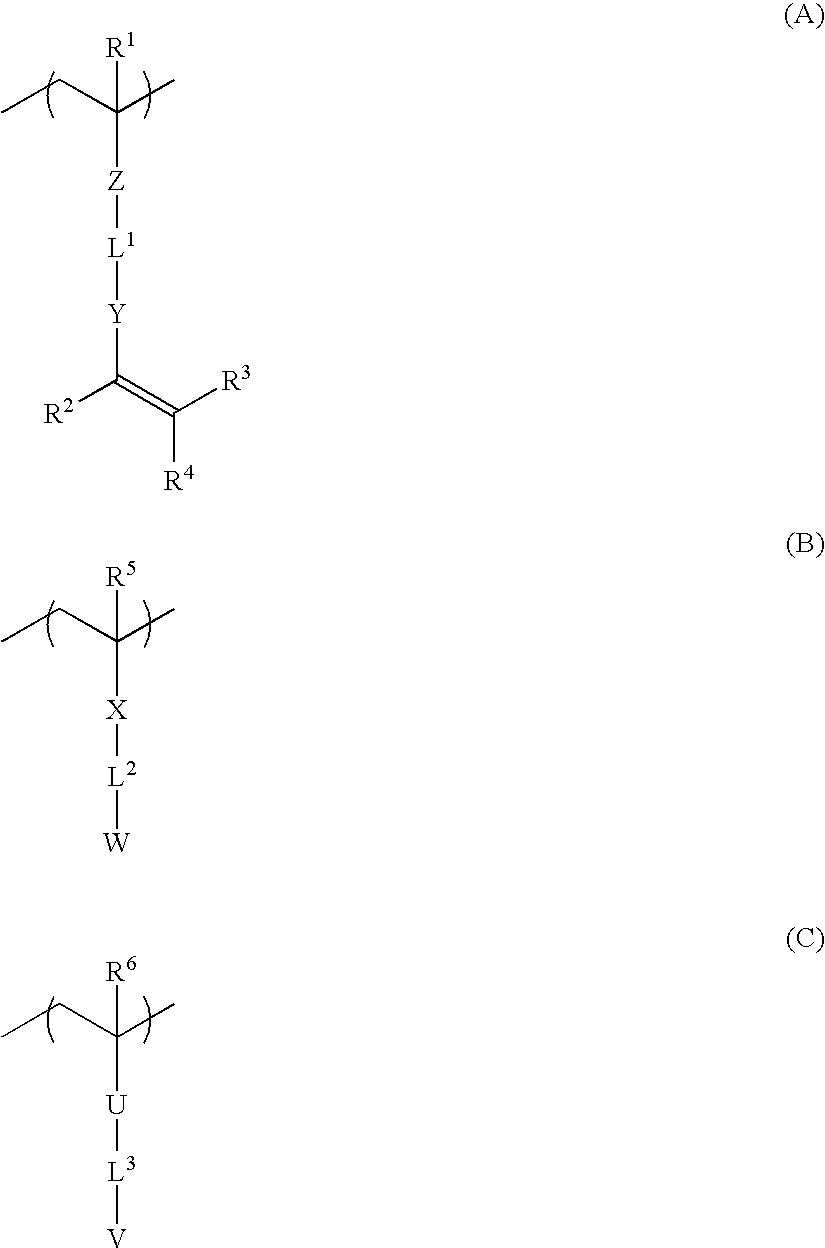Composition for forming layer to be plated, method of producing metal pattern material, metal pattern material
a technology of metal pattern material and forming layer, which is applied in the direction of instruments, transportation and packaging, coatings, etc., can solve the problems of complex process, long development process time, and possible deformation of high-frequency characteristics
- Summary
- Abstract
- Description
- Claims
- Application Information
AI Technical Summary
Benefits of technology
Problems solved by technology
Method used
Image
Examples
examples
[0359]In the following, details of the invention will be explained with reference to the Examines. However, the invention is not limited thereto. The terms “%” and “parts” are based on mass, unless otherwise specified.
Synthesis Example
Synthesis of Specific Polymer A
[0360]10 g of N,N-dimethylacetoamide were placed in a 500 ml three-neck flask, and were heated to 65° C. under a nitrogen stream. Then, 6.61 g of monomer M (following structure), 9.01 g of 2-cyanoethyl acrylate (manufactured by TOKYO CHEMICAL INDUSTRY CO., LTD.), 15.14 g of a monomer having a carboxyl group directly bound to an alicyclic structure (trade name: HOA-HH, following structure, manufactured by KYOEISHA CHEMICAL CO., LTD), and 10 g of a N,N-dimethylaceamide solution containing 0.32 g of 2,2′-azobis(2,4-dimethylvaleronitrile) (trade name: V-65, manufactured by WAKO PURE CHEMICAL INDUSTRIES, LTD.) were dropped in the flask over 4 hours. After the dropping, the content of the flask was stirred for 3 hours. Thereaf...
synthesis example
Synthesis of Specific Polymer D
[0370]13.4 g of N,N-dimethylacetoamide were placed in a 500 ml three-neck flask, and were heated to 65° C. under a nitrogen stream. Then, 13.22 g of monomer M, 17.80 g of 3-cyanopropyl acrylate (manufactured by TOKYO CHEMICAL INDUSTRY CO., LTD.), 9.23 g of acrylic acid (manufactured by TOKYO CHEMICAL INDUSTRY CO., LTD.), and 13 g of a N,N-dimethylaceamide solution containing 0.63 g of 2,2′-azobis(2,4-dimethylvaleronitrile) (trade name: V-65, manufactured by WAKO PURE CHEMICAL INDUSTRIES, LTD.) were dropped in the flask over 4 hours. After the dropping, the content of the flask was stirred for 3 hours. Thereafter, 67 g of N—N-dimethylacetoamide were added to the flask and the reaction solution was cooled to room temperature.
[0371]To the above reaction solution, 0.11 g of 4-hydroxy TEMPO (manufactured by TOKYO CHEMICAL INDUSTRY CO., LTD.) and 48.6 g of triethylamine were added and the reaction solution was allowed to react at room temperature for 4 hours...
example 1
[0372]Preparation of Composition for Forming Layer to be Plated
[0373]0.2 g of specific polymer A obtained by the above synthesis method, 0.04 g of sodium carbonate, 1.5 g of water and 0.3 g of acetonitrile were mixed and stirred, and a composition for forming a layer to be plated was prepared.
[0374]Preparation of Substrate
[0375]An adhesion-aiding layer was formed by applying a 9% cyclohexane solution of ABS resin (manufactured by SIGMA-ALDRICH JAPAN K.K.) onto a glass epoxy substrate by a spin coat method (conditions: 250 rpm for 5 seconds and 750 rpm for 20 seconds), and then drying it to form an adhesion-aiding layer. Substrate A1 was thus obtained.
[0376]Formation of Layer to be Plated
[0377]The composition for forming a layer to be plated was applied onto the adhesion-aiding layer of substrate A1 to a thickness of 1 μm by a spin coat method, and was dried at 80° C. for 30 minutes.
[0378]Thereafter, the composition was exposed to light in a patterned manner through a photomask for 3...
PUM
| Property | Measurement | Unit |
|---|---|---|
| boiling point | aaaaa | aaaaa |
| boiling point | aaaaa | aaaaa |
| boiling point | aaaaa | aaaaa |
Abstract
Description
Claims
Application Information
 Login to View More
Login to View More - R&D
- Intellectual Property
- Life Sciences
- Materials
- Tech Scout
- Unparalleled Data Quality
- Higher Quality Content
- 60% Fewer Hallucinations
Browse by: Latest US Patents, China's latest patents, Technical Efficacy Thesaurus, Application Domain, Technology Topic, Popular Technical Reports.
© 2025 PatSnap. All rights reserved.Legal|Privacy policy|Modern Slavery Act Transparency Statement|Sitemap|About US| Contact US: help@patsnap.com



